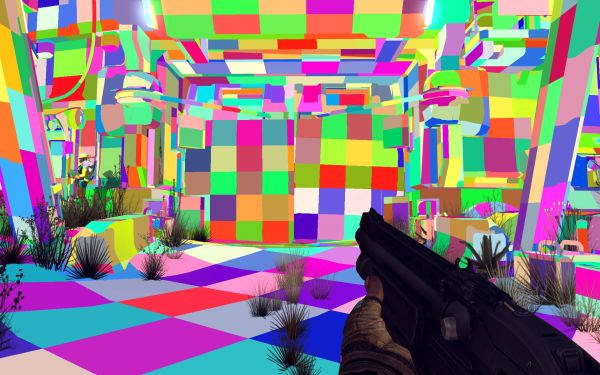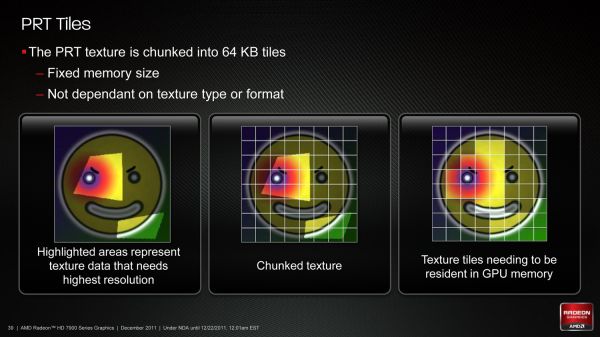AMD Radeon HD 7970 Review: 28nm And Graphics Core Next, Together As One
by Ryan Smith on December 22, 2011 12:00 AM EST- Posted in
- GPUs
- AMD
- Radeon
- ATI
- Radeon HD 7000
Partially Resident Textures: Not Your Father’s Megatexture
John Carmack’s id Software may not be the engine licensing powerhouse it was back in the Quake 3 days, but that hasn’t changed the revolutionary nature of his engine designs. The reason we bring this up is because there’s a great deal of GPU technology that can be directly mapped to concepts Carmack first implemented. For id Tech 4 Carmack implemented shadow volume technology, which was then first implemented in hardware by NVIDIA as their UltraShadow technology, and has since then been implemented in a number of GPUs. For id Tech 5 the trend has continued, now with AMD doing a hardware implementation of a Carmack inspired technology.
Among the features added to Graphics Core Next that were explicitly for gaming, the final feature was Partially Resident Textures, which many of you are probably more familiar with in concept as Carmack’s MegaTexture technology. The concept behind PRT/Megatexture is that rather than being treated as singular entities, due to their size textures should be broken down into smaller tiles, and then the tiles can be used as necessary. If a complete texture isn’t needed, then rather than loading the entire texture only the relevant tiles can be loaded while the irrelevant tiles can be skipped or loaded at a low quality. Ultimately this technology is designed to improve texture streaming by streaming tiles instead of whole textures, reducing the amount of unnecessary texture data that is streamed.
Currently MegaTexture does this entirely in software using existing OpenGL 3.2 APIs, but AMD believes that more next-generation game engines will use this type of texturing technology. Which makes it something worth targeting, as if they can implement it faster in hardware and get developers to use it, then it will improve game performance on their cards. Again this is similar to volume shadows, where hardware implementations sped up the process.
In order to implement this in hardware AMD has to handle two things: texture conversion, and cache management. With texture conversion, textures need to be read and broken up into tiles; AMD is going with a texture format agnostic method here that can simply chunk textures as they stand, keeping the resulting tiles in the same format. For AMD’s technology each tile will be 64KB, which for an uncompressed 32bit texture would be enough room for a 128 x 128 chunk.
The second aspect of PRT is managing the tiles. In essence PRT reduces local video memory to a very large cache, where tiles are mapped/pinned as necessary and then evicted as per the cache rules, and elsewhere the hardware handles page/tile translation should a tile not already be in the cache. Large tomes have been written on caching methods, and this aspect is of particular interest to AMD because what they learn about caching here they can apply to graphical workloads (i.e. professional) and not just gaming.
To that end AMD put together a technology demo for PRT based on Per-Face Texture Mapping (PTEX), a Disney-developed texture mapping technique that maps textures to polygons in a 1:1 ratio. Disney uses this technique for production rendering, as by constraining textures to a single polygon they don’t have to deal with any complexities that arise as a result of mapping a texture over multiple polygons. In the case of AMD’s demo it not only benefits for the reasons that Disney uses it, but also because when combined with tessellation it trivializes vector displacement, making art generation for tessellated games much easier to create. Finally, PRT fits into all of this by improving the efficiency of accessing and storing the Ptex texture chunks.
Wrapping things up, for the time being while Southern Islands will bring hardware support for PRT software support will remain limited. As D3D is not normally extensible it’s really only possible to easily access the feature from other APIs (e.g. OpenGL), which when it comes to games is going to greatly limit the adoption of the technology. AMD of course is working on the issue, but there are few ways around D3D’s tight restrictions on non-standard features.

















292 Comments
View All Comments
Esbornia - Thursday, December 22, 2011 - link
Fan boy much?CeriseCogburn - Thursday, March 8, 2012 - link
Finally, piroroadkill, Esbornia - the gentleman ericore merely stated what all the articles here have done as analysis while the radeonite fans repeated it ad infinitum screaming nvidia's giant core count doesn't give the percentage increase it should considering transistor increase.Now, when it's amd's turn, we get ericore under 3 attacks in a row...---
So you three all take it back concerning fermi ?
maverickuw - Thursday, December 22, 2011 - link
I want to know when the 7950 will come out and hopefully it'll come out at $400duploxxx - Thursday, December 22, 2011 - link
Only the fact that ATI is able to bring a new architecture on a new process and result in such a performance increase for that power consumption is a clear winner.looking at the past with Fermy 1st launch and even Cayman VLIW4 they had much more issues to start with.
nice job, while probably nv680 will be more performing it will take them at least a while to release that product and it will need to be also huge in size.
ecuador - Thursday, December 22, 2011 - link
Nice review, although I really think testing 1680x1050 for a $550 is a big waste of time, which could have to perhaps multi-monitor testing etc.Esbornia - Thursday, December 22, 2011 - link
Its Anand you should expect this kind of shiet.Ryan Smith - Thursday, December 22, 2011 - link
In this case the purpose of 1680 is to allow us to draw comparisons to low-end cards and older cards, which is something we consider to be important. The 8800GT and 3870 in particular do not offer meaningful performance at 1920.poohbear - Thursday, December 22, 2011 - link
Why do you bencmark @ 1920x1200 resolution? according to the Steam December survey only 8% of gamers have that resolution, whereas 24% have 1920x1080 and 18% use 1680x1050 (the 2 most popular). Also, minimum FPS would be nice to know in your benchmarks, that is really useful for us! just a heads up for next time u benchmark a video card! Otherwise nice review! lotsa good info at the beginning!:)Galcobar - Thursday, December 22, 2011 - link
Page 4, comments section.Esbornia - Thursday, December 22, 2011 - link
They dont want to show the improvements on min FPS cause they hate AMD, you should know that already.